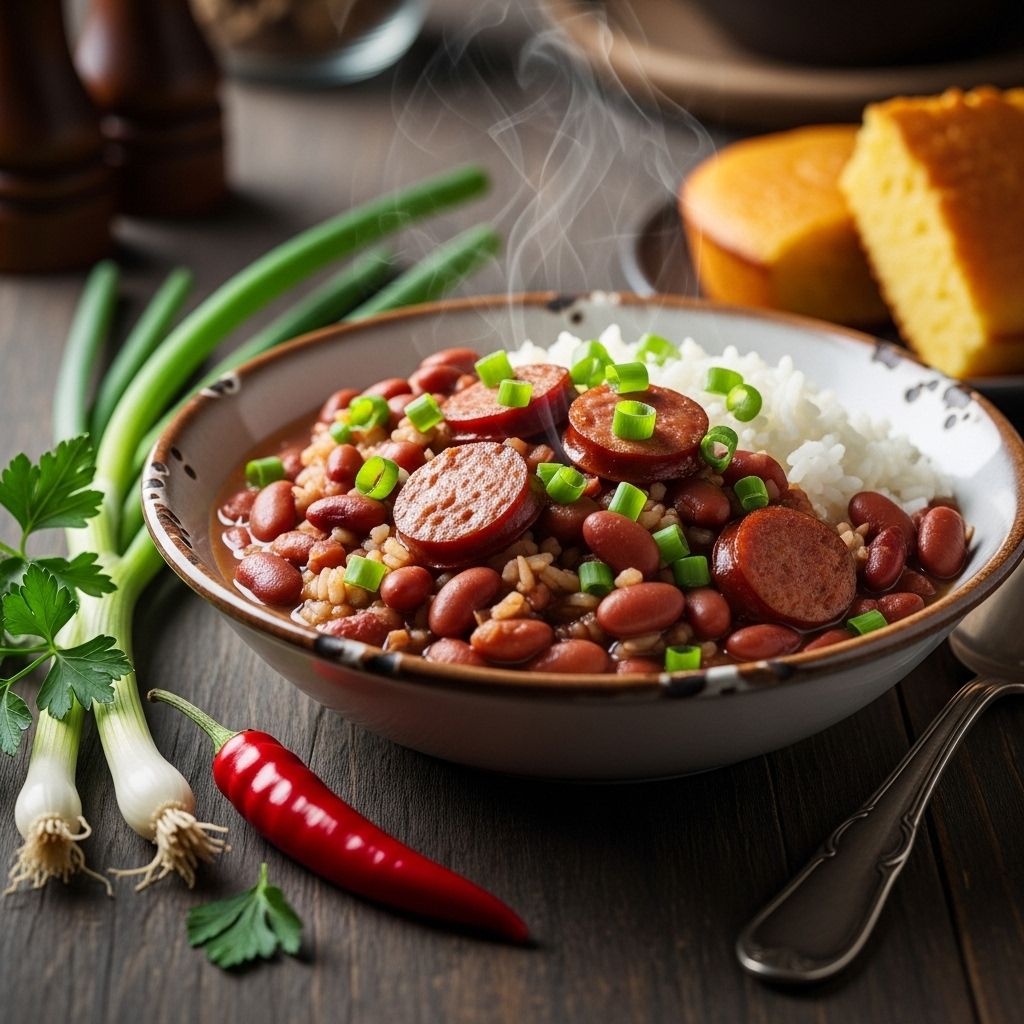New Orleans-Style Red Beans And Rice: Authentic Flavor Guide
Patient simmering and mashing transform humble pantry staples into a velvety savory dish.

New Orleans-Style Red Beans and Rice: Tradition, Technique, and Taste
Red beans and rice is a hallmark of New Orleans cuisine, renowned as both a comforting everyday meal and a deeply rooted cultural ritual. Long associated with family gatherings and lively Mondays, this dish encapsulates the heart of Creole cooking.
Table of Contents
- The History and Culture of Red Beans and Rice
- Essential Ingredients
- Mastering the Technique
- How Beans Become Creamy and Savory
- Serving and Presentation
- Tips, Tricks, and Variations
- Frequently Asked Questions
The History and Culture of Red Beans and Rice
Red beans and rice is much more than a dish in New Orleans; it’s a Southern staple that speaks to the city’s Creole and Cajun roots. Traditionally eaten on Mondays, this meal was prepared as families did their weekly laundry—its long, slow simmer required minimal attention. The custom persists today as a taste of home, hospitality, and heritage.
- Creole Influence: Incorporates Spanish, French, African, and Caribbean cooking methods and flavors.
- Monday Ritual: Linked to the wash day tradition, as it simmers unattended for hours.
- Community: Often served in large batches for gatherings or family meals.
What Makes It New Orleans-Style?
The blend of cured pork, slow-cooked kidney beans, fresh aromatics, and signature seasoning sets New Orleans-style red beans and rice apart from other bean dishes. The secret is coaxing maximum flavor and creaminess from simple ingredients through time-honored technique.
Essential Ingredients
What you choose to put in your red beans and rice shapes the final flavor. Authentic recipes demand attention to each element:
- Dried Red Kidney Beans: The foundation. Soaked overnight for faster, more even cooking. Using dried beans yields a creamier texture versus canned.
- Pork for Flavor: Traditionally a combination of pickled pork, smoked ham hocks, andouille sausage, or tasso ham.
- The Holy Trinity: This classic Louisiana mirepoix combines onion, green bell pepper, and celery—the starting base for most Creole and Cajun dishes.
- Garlic: Often added generously, either fresh or roasted.
- Herbs and Spices:
- Bay leaves
- Dried thyme (or fresh sprigs)
- Ground cayenne pepper (for heat)
- Sage (optional, adds earthiness)
- Salt and freshly ground black pepper
- Stock or Water: Enough to cover the beans by a couple of inches, often chicken stock or water with added pork bits and bones.
- Rice: Always served with long-grain white rice, ideally fluffy and distinct.
Key Ingredient Variations
While traditional recipes use pickled pork and smoked meats like andouille sausage or ham hocks, regional and personal variations can swap in:
- Salt pork, slab bacon, or pancetta for fatty, salty notes.
- Turkey sausage, vegan sausage, or omit the meat entirely for a vegetarian version (substitute with smoked paprika or liquid smoke for depth).
- Creole seasoning blends can be used for added punch.
Mastering the Technique
The true character of red beans and rice emerges from careful, layered cooking and patience. Here’s a detailed method mirroring the tested techniques from New Orleans experts:
- Soak the Beans:
Begin by soaking dried red kidney beans overnight in plenty of cold water. This will soften the beans, shorten cooking time, and improve texture. For a quick soak, cover with boiling water and let sit for an hour, although overnight soaking is preferred for authenticity.
- Build the Flavor Base:
Render fat from your chosen pork in a large Dutch oven or heavy-bottomed pot until golden and just crisp. Add chopped onions, bell pepper, and celery, sautéing until vegetables soften and develop golden edges—this intensifies their sweetness and depth.
- Add minced garlic and fry until fragrant.
- Scatter in thyme, sage, cayenne, and bay leaves. Fry spices briefly in pork fat until aromatic to unlock their flavors.
- Simmer with Meats and Beans:
Stir in your soaked and drained beans, along with diced smoked meats and enough water or stock to cover by about two inches. Use a wooden spoon to scrape up the browned bits (fond) from the pot bottom for extra flavor.
- Bring to a boil, then reduce to a gentle simmer.
- Cover loosely and cook for 2–2.5 hours. Older beans may require up to 3 hours to fully soften.
- Stir and Mash for Creaminess:
The last step is crucial for authentic texture. Once the beans are thoroughly tender, uncover and increase the heat slightly. Mash about a quarter of the beans directly against the pot side using a sturdy spoon or spatula. Stir this mashed portion back in—this thickens and emulsifies the sauce, creating the signature creamy gravy.
- Final Seasoning:
Taste and adjust salt, pepper, and cayenne for a kick. Remove the bay leaves and any pork bones before serving.
- Cook the Rice:
While beans simmer, steam long-grain white rice separately. Fluffy rice provides the perfect, absorbent base for the beans.
- Serve:
Spoon red beans generously over rice, with sausage or smoked pork atop. Garnish with chopped green onions or parsley for extra color and freshness.
How Beans Become Creamy and Savory
A major hallmark of New Orleans-style red beans and rice is its creamy, rich sauce, which is quite different from the thin broth found in many bean dishes. The trick lies in:
- Mashing Some Beans: As the beans finish cooking, mash a portion to release starch and thicken the liquid. This creates a thick, almost gravy-like consistency.
- Emulsifying Fat: The rendered pork fat and any oil from sausage meld into the bean mash, enriching the sauce and amplifying flavor.
- Sufficient Simmering Time: Extended gentle cooking allows the beans to soften and break down properly, making the sauce velvety.
Why Use Dried Beans? While canned beans save time, dried beans provide better flavor and a more authentic, lush texture. They also absorb more flavor from the aromatics and meats as they cook.
Serving and Presentation
Red beans and rice is a naturally hearty dish, perfect as a standalone meal or as part of a larger Southern spread. To serve it with classic touch:
- Rice First: Heap a mound of warm, fluffy white rice in a bowl.
- Ladle Beans Over: Spoon the rich, smoky beans over the top, ensuring plenty of creamy sauce.
- Meats on Top: Arrange sliced sausage, ham, or pickled pork on the beans for visual appeal and easy access.
- Finishing Touches: Scattered green onions, chopped parsley, and hot sauce offered on the side give diners a chance to add freshness or heat.
Traditional Sides and Accompaniments
- Crusty French bread for sopping up sauce.
- Hot sauce bottles on the table for those who crave a firey finish.
- Collard greens, fried chicken, or coleslaw round out the meal at larger gatherings.
Tips, Tricks, and Variations
For mastering red beans and rice at home, keep in mind these expert tips:
- Soak Your Beans: Always soak dried beans overnight to ensure even cooking and a creamy core.
- Balance the Smoke and Salt: Smoked meats produce intense flavors, so taste at the end and adjust salt as needed.
- Use the Fond: The browned bits at the bottom when frying pork and vegetables (“fond”) are packed with savory flavor—scrape them up with your liquid.
- Vary Your Meats: Experiment with pickled pork, ham hocks, smoked turkey wings, or vegetarian sausage to find your signature take.
- Cook Low and Slow: Allow ample time for simmering. Rushing the process will sacrifice texture and depth.
- Leftovers Taste Better: Like many slow-cooked dishes, red beans and rice improves overnight as flavors meld. Reheat gently for second-day excellence.
Common Variations
| Variation | Description |
|---|---|
| Vegetarian/Vegan | Omit all pork and sausage, substitute with smoked paprika and vegetable stock for flavor. |
| Spicy | Increase cayenne or add diced hot peppers. |
| Extra Smoky | Use double the smoked meats or add a dash of liquid smoke. |
| Creole Style | Add tomatoes, extra herbs, or Creole seasoning blends. |
| Gluten-Free | Use naturally gluten-free sausage and real rice. |
Frequently Asked Questions (FAQs)
Q: What type of beans should I use?
A: Authentic New Orleans-style red beans and rice is made with dried red kidney beans for their creamy texture and robust flavor. Small red beans also work, but kidney beans are classic.
Q: Can I use canned beans?
A: For the best flavor and consistency, use dried beans. However, canned beans can be used for speed, but will result in a thinner sauce and less integrated flavor. Adjust simmering times accordingly.
Q: Is this dish spicy?
A: It has a gentle heat from cayenne and black pepper, but the spice level can be tailored to taste. Serve with hot sauce for individual heat adjustments.
Q: What is pickled pork, and is it necessary?
A: Pickled pork is a traditional Creole staple, made by curing pork with pickling spices and vinegar. It brings tangy depth, but you can substitute with ham hocks, regular pork shoulder, or even slab bacon if unavailable.
Q: How do I store and reheat leftovers?
A: Allow beans and rice to cool separately. Store in airtight containers for up to five days in the refrigerator. Gently reheat beans on the stovetop or in the microwave, adding water or stock as needed to loosen the sauce.
Q: Can I freeze red beans and rice?
A: Yes! Freeze beans (without rice) in freezer-safe containers for up to three months. Thaw overnight in the fridge and reheat gently. Cook fresh rice for the best results upon serving.
Bring the Spirit of New Orleans Home
Mastering New Orleans-style red beans and rice is about more than following a recipe—it’s about embracing a culinary ritual. Simple ingredients, patient technique, and soulful flavor combine to make this dish a perennial favorite from the bayou to your dinner table. Whether you’re honoring tradition or creating new ones, the rich, smoky comfort of this iconic meal is always worth the wait.
References
Read full bio of Srija Burman












